Sanyo
|
The Sanyo logo used since 1987 | |
| Subsidiary | |
| Industry | Electronics |
| Founded |
1947 1949 (incorporated) |
| Headquarters |
Moriguchi, Osaka, Japan Watford, United Kingdom |
Key people | Toshio Iue, Seiichiro Sano |
| Products | Consumer electronics, Dry batteries, and Cellular phones |
| Revenue |
|
|
| |
|
| |
| Total assets |
|
| Total equity |
|
Number of employees |
104,882 (consolidated) 9,504 (non-consolidated) (March 31, 2011)[2] |
| Parent | Panasonic (2011–present) |
| Website |
www |
Sanyo Electric Co., Ltd. (三洋電機株式会社 San'yō Denki Kabushiki-gaisha) is a Japanese major electronics company and formerly a member of the Fortune Global 500 whose headquarters was located in Moriguchi, Osaka prefecture, Japan. Sanyo had over 230 subsidiaries and affiliates.[2] Sanyo was founded by Toshio Iue.
On December 21, 2009, Panasonic completed a 400 billion yen ($4.5 billion) acquisition of a 50.2% stake in Sanyo, making Sanyo a subsidiary of Panasonic.[3][4] In 2011, Sanyo became a wholly owned subsidiary of Panasonic Corporation.
Corporate culture
Sanyo utilizes an extensive socialization process for new employees, so that they will be acclimatized to Sanyo's corporate culture.[5] New employees take a five-month course during which they eat together and share company-provided sleeping accommodation. They learn everything from basic job requirements to company expectations for personal grooming and the appropriate way in which to address their coworkers and superiors.
History
Beginnings
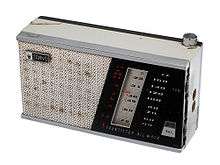
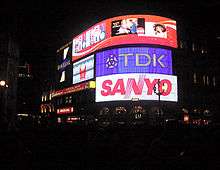
Sanyo was founded when Toshio Iue (井植 歳男 Iue Toshio, 1902–1969), the brother-in-law of Konosuke Matsushita and also a former Matsushita employee, was lent an unused Matsushita plant in 1947 and used it to make bicycle generator lamps. Sanyo was incorporated in 1949; in 1952 it made Japan's first plastic radio and in 1954 Japan's first pulsator-type washing machine.[2] The company's name means three oceans in Japanese, referring to the founder's ambition to sell their products worldwide, across the Atlantic, Pacific, and Indian oceans.
This ambition was realized in the late 1970s, when Sanyo introduced car stereos and home electronics to the North American consumer market and embarked on a heavy television-based advertising campaign. Sanyo expanded their North American presence with the purchase of Whirlpool Corporation's television business, Warwick Electronics, which manufactured televisions for Sears.[6]
In 1982, Sanyo started selling the MBC-1000 series of CP/M computers.[7] In 1983[8] it introduced the MBC-550 PC, the lowest-cost IBM PC compatible personal computer available at the time,[9] but its lack of full compatibility drove Sanyo from the market and no follow-on models were released.
Technologically Sanyo has had good ties with Sony, supporting the Betamax video format from invention until the mid-1980s (the best selling video recorder in the UK in 1983 was the Sanyo VTC5000), while producing the VHS video format at the same time for the Fisher brand during the early 1980s, and later being an early adopter of the highly successful Video8 camcorder format. More recently, though, Sanyo decided against supporting Sony's format, the Blu-ray Disc, and instead gave its backing to Toshiba's HD DVD. This was ultimately unsuccessful, however, as Sony's Blu-ray triumphed.[10]
In North America, Sanyo manufactured CDMA cellular phones exclusively for Sprint's Sprint PCS brand in the United States, and for Bell Mobility in Canada.
Acquisition
The 2004 Chūetsu earthquake severely damaged Sanyo's semiconductor plant and as a result Sanyo recorded a huge financial loss for that year. The 2005 fiscal year financial results saw a 205 billion yen net income loss. The same year the company announced a restructuring plan called the Sanyo Evolution Project, launching a new corporate vision to make the corporation into an environmental company, plowing investment into strong products like rechargeable batteries, solar photovoltaics, air conditioning, hybrid car batteries and key consumer electronics such as the Xacti camera, projectors and mobile phones.

Sanyo posted signs of recovery after the announcement of positive operating income of 2.6 billion yen. Sanyo remains the world number one producer of rechargeable batteries. Recent product innovations in this area include the Eneloop Low self-discharge NiMH battery, a "hybrid" rechargeable NiMH (Nickel-metal hydride battery) which, unlike typical NiMH cells, can be used from-the-package without an initial recharge cycle and retain a charge significantly longer than batteries using standard NiMH battery design. The Eneloop line competes against similar products such as Rayovac's "Hybrid Rechargeable" line.
On November 24, 2006, Sanyo announced heavy losses and job cuts.[11]
Tomoyo Nonaka, a former NHK anchorwoman who was appointed Chairman of the company, stepped down in March 2007.[12] The President, Toshimasa Iue, also stepped down in April of that year; Seiichiro Sano was appointed to head the company effective April 2007. In October 2007, Sanyo cancelled a 110 billion yen ( million) sale of its semiconductor business, blaming the global credit crisis for the decision and stating that after exploring its other options, it had decided to keep the business and develop it as part of its portfolio.[13]
On April 1, 2008, they sold their cell phone division to Kyocera, laying off a third of their U.S. employees.
On November 2, 2008, Sanyo and Panasonic announced that they have agreed on the main points of a proposed buyout that would make Sanyo a subsidiary of Panasonic[14] and a formal announcement of the acquisition was made on Sanyo's web site on December 19, 2008.[15] They became a subsidiary of Panasonic on December 21, 2009.[3]
In 2010, Sanyo sold its semiconductor operations to ON Semiconductor. [16]
On July 29, 2010, Panasonic reached an agreement to acquire the remaining shares of Panasonic Electric Works and Sanyo shares for $9.4 billion.[17][18][19]
By March 2012, parent company Panasonic plans to terminate the Sanyo brand, however it will remain on some of the products where the Sanyo brand still holds value to consumers.[20]
In August 2013, a 51% majority stake in Chinese company Hefei Royalstar Sanyo, a 2000 joint venture between Japanese Sanyo and Chinese government investment company Hefei, was purchased by American multinational manufacturer Whirlpool Corporation for $552 million.[21]
Energy
Solar cells and plants
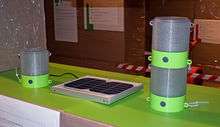
The Sanyo HIT (Heterojunction with Intrinsic Thin layer) solar cell is composed of a mono thin crystalline silicon wafer surrounded by ultra-thin amorphous silicon layers.[22]
Sanyo Energy opened its solar module assembly plants in Hungary and in Mexico in 2004, and in 2006 it produced solar modules worth $213 million. In 2007, Sanyo completed a new unit at its solar module plant in Hungary that was to triple its annual capacity to 720,000 units in 2008.[23]
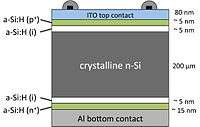
Plans to expand production were based on rising demands for Sanyo Hungary products, whose leading markets are Germany, Italy, Spain and the Scandinavian countries. The plant at Dorog, outside Budapest, will be Sanyo Electric's largest facility producing solar modules in the entire world.[23]
In late September 2008, Sanyo Electric Company, Ltd. announced its decision to build a manufacturing plant for solar ingots and wafers (the building blocks for silicon solar cells) in Inagi, Tokyo. The plant will begin operating in October 2009 and will reach its full production capacity of 70 megawatts (MW) of solar wafers per year by April 2010. Sanyo and Nippon Oil have decided to launch a joint company for the production and sale of thin-film solar panels, to be named Sanyo Eneos Solar Co., Ltd. The new joint company will start production and sales at an initial scale of 80 MW and gradually increase its production capacity. For this joint project, Sanyo will draw on its solar cell technologies, based on the technology acquired through the development of the HIT Solar Cell.[24]
Sanyo Electric is also responsible for the construction of the Solar Ark.
Rechargeable batteries
Sanyo pioneered the production of nickel cadmium batteries in 1964, nickel metal hydride batteries in 1990, lithium ion batteries in 1994, and lithium polymer batteries in 1999. Sanyo is notable for their Eneloop brand of NiMh batteries that can be recharged thousands of times. In 2000, it acquired Toshiba's nickel metal hydride battery business, including the Takasaki factory.[25] Since the acquisition of Sanyo by Panasonic the Takasaki factory transferred ownership to FDK TWICELL CO., LTD.
Electric vehicle batteries
Sanyo Electric Co Ltd. supplies nickel metal hydride batteries (NiMH) to Honda Motor Co. Ltd., Ford Motor Co. and Volkswagen. Sanyo is developing NiMH batteries for hybrid electric vehicles with the Volkswagen group.[26] Sanyo lithium-ion batteries for Plug-in HEV will also be housed in SUZUKI's fleet vehicles.
Sanyo Electric plans to raise monthly production of NiMH batteries for hybrid vehicles from the current 1 million units to up to 2.5 million by the end of fiscal 2005.[27]
Sanyo India
Televisions
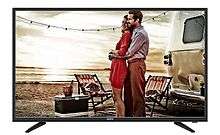
Panasonic reintroduced the Sanyo brand in India, with the launch of Sanyo LED TV range on August 8, 2016 exclusively on Amazon India.[28] With the tagline "Together Viewing – That's what TV is", the televisions have been positioned as a quality product backed by reliable service.[29] All Sanyo televisions are made from A+ grade panels and have multiple connectivity options. Since launch, Sanyo has become the most reviewed brand in the television category on Amazon.[30]
Air conditioners
Sanyo has worked with Energy Efficiency Services Limited to develop a unique first-of-its-kind super efficient 1.5 ton Invertor air conditioner with an Indian Seasonal Energy Efficiency Ratio (ISEER) rating of 5.2. This makes it the most energy efficient air conditioner in its category in India. Distribution of these air conditioners is expected to begin from August 2017.[31]
Sanyo USA
Though founded in Japan, Sanyo Electric Co Ltd. has sold TVs in America for over 50 years; Sanyo TV USA is currently headquartered in San Diego, California with facilities located in Tijuana, Mexico. Because of its relatively high price compared to competitors, Sanyo competes on quality and value. TopTenReviews.com quotes Sanyo as producing LCD TVs "...with one of the best pictures, great sound and all the high-quality specs you expect from a top LCD TV," earning the website's 2014 Gold Award.[32]
Many of Sanyo's television sets also offer MHL compatibility along with ROKU READY branding via HDMI, meaning the TVs are compatible with Roku's MHL-specific streaming stick. This stick, sometimes included with purchase (such as with the Sanyo FVF5044[33]), enables video streaming and other online media access abilities as an affordable alternative to competing comparable Smart TVs; the TV's original remote is capable of browsing the service. Multiple models also possess USB ports which allow for immediate photo sharing ability directly off the stick without any additional software/upgrades.[34]
Sanyo has served over 40 million American consumers as their choice for home theater entertainment. According to the NPD Group Retail Tracking Service, in 2013, 3 Sanyo TV models were among the best-selling television models in the United States while Sanyo's 55-inch HDTV was labeled as one of the top 5 selling TVs in its class. (Units sold from January 2013 – December 2013: Best Selling 39" HDTV in U.S., Best Selling 42" HDTV in U.S., Best Selling 58" HDTV in U.S.)[35]
Sponsorship
Sanyo was the major sponsor of the Penrith Panthers Rugby League team in the National Rugby League (Australia) from 2000 to 2012. It is the longest sponsorship of any team in Australian Rugby League history. In football, Sanyo sponsored the Argentine Club Atlético River Plate from 1992 to 1995 and Brazilian Coritiba Foot Ball Club from 1995 to 1999.
See also
| Wikimedia Commons has media related to Sanyo. |
- Kyocera Communications
- List of digital camera brands
- Mitsubishi Heavy Industries
- Panasonic Wild Knights
- Primearth EV Energy Co
References
- 1 2 3 4 5 Financial Results for FY 2011
- 1 2 3 "Outline". panasonic.net. Retrieved 19 February 2015.
- 1 2 "Sanyo Electric Co., Ltd. - Panasonic". sanyo.com. Retrieved 19 February 2015.
- ↑ Daisuke Wakabayashi (5 February 2010). "Sanyo Deal Hits Panasonic Results". WSJ. Retrieved 19 February 2015.
- ↑ J. Impoco, "Basic Training, Sanyo Style". U.S. News & World Report, July 13, 1992, pp. 46–48.
- ↑ http://assets.whirlpoolcorp.com/wp-content/uploads/history_100years_factsheet.pdf
- ↑ Myer, Edwin W. (29 November 1982). "Hardware Review: Sanyo MBC 1000 Small Business Computer". InfoWorld. InfoWorld Media Group. p. 101. Retrieved 14 Feb 2017.
- ↑ Shea, Tom (11 July 1983). "Sanyo Developing IBM Clone". InfoWorld. InfoWorld Media Group. p. 1. Retrieved 14 Feb 2017.
- ↑ "Sanyo 555, small business computers. (evaluation)".
- ↑ "Toshiba to give up on HD DVD, end format war: source". Reuters. February 16, 2008.
- ↑ "The Japan Times - News on Japan, Business News, Opinion, Sports, Entertainment and More". The Japan Times. Retrieved 19 February 2015.
- ↑ "Sanyo Chairwoman Tomoyo Nonaka resigns". UPI. Retrieved 19 February 2015.
- ↑ "Login". timesonline.co.uk. Retrieved 19 February 2015.
- ↑ NHKニュース 三洋電機 子会社化で大筋合意 (NHK News: Agreement to Main Points to make Sanyo Electric a Subsidiary) Retrieved on November 2, 2008
- ↑ Sanyo Press Release Retrieved on May 14, 2009
- ↑ "www.sanyosemi.com has been integrated into www.onsemi.com".
- ↑ "Panasonic Electric Works - Panasonic" (PDF). panasonic-electric-works.net. Retrieved 19 February 2015.
- ↑ "Panasonic buying Sanyo and other unit for $9.4 billion". reuters.com. Retrieved 19 February 2015.
- ↑ "Consolidation Continues: Panasonic To Buy Sanyo". Renewable Energy World. Retrieved 19 February 2015.
- ↑ Brand name of Sanyo to be basically terminated in April 2012
- ↑ Rohit T. K. in Bangalore and James B. Kelleher (13 August 2013). "Whirlpool buys 51 percent stake in China appliance maker". Reuters.
- ↑ http://solar.sanyo.com/hit.html
- 1 2 Japan's Sanyo expands Hungary solar plant
- ↑ "Power & Energy Technology - IHS Technology".
- ↑ "Toshiba : Press Releases 27 April, 2001".
- ↑ "Sanyo completes construction of lithium-ion battery facility in Japan" (Press release). Sanyo via Autoblog Green. 2010-08-10. Retrieved 2010-08-10.
- ↑ BioAge Media. "Green Car Congress: Sanyo to More than Double NiMH Battery Production Based on Hybrid Demand".
- ↑ "Sanyo India Launch". Financial Express. Retrieved 11 August 2016.
- ↑ "Sanyo India TVs". Sanyo India Website. Retrieved 11 August 2016.
- ↑ "Sanyo TV reviews". Amazon. Retrieved 1 June 2017.
- ↑ "Sanyo EESL AC". Economic Times. Retrieved 24 May 2017.
- ↑ "Sanyo LCD". TopTenREVIEWS. Retrieved 19 February 2015.
- ↑ "Sanyo FVF5044". PCMAG. Retrieved 19 February 2015.
- ↑ "Sanyo introduces 65-inch LCD TV for $998". CNET. CBS Interactive. Retrieved 19 February 2015.
- ↑ "Consumer Market Research - Business Solutions - npd.com". npd.com. Retrieved 19 February 2015.
